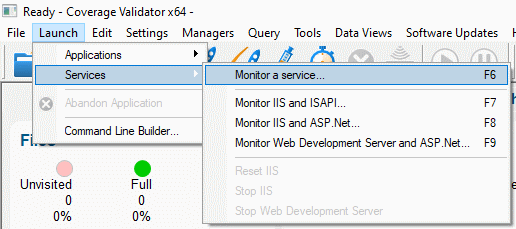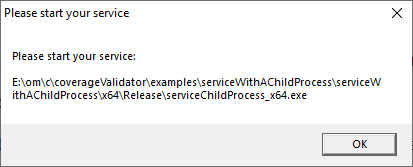Coverage Validator Tutorials

The Tutorials

Getting Started

Why is Coverage Testing Important?

Static Linking MFC and CRT

Dynamic Linking MFC and CRT

Code Coverage Sample Application #1

Code Coverage Sample Application #2

Collecting code coverage in a child process

Getting code coverage for a .Net Core application

Getting code coverage for a .Net Core application child process

Code Coverage for a service

Code Coverage for a service child process

Collecting code coverage in an IIS ISAPI DLL

Code Coverage of ASP.Net with IIS

Collecting code coverage for ASP.Net with Web Development Server

Getting Code Coverage for a Dynamically Linked Library

Excluding Code Coverage for a Dynamically Linked Library

Getting Code Coverage for a Statically Linked Library

Excluding Code Coverage for a Statically Linked Library

Wizard Mode/Dialog Mode.

Interactive Profiling

Merging Samples

Automatic Merging

Command Line

Regression Testing

Identifying Unused Code
Code Coverage for a service child process
This tutorial describes how to collect code coverage for a child process of a service (or any descendant process of the service).
This tutorial covers the following:
-
- Modifying an application to use the NT Service API
- How to use the Coverage Validator user interface to collect code coverage for the service’s child process.
Related tutorials:
Code coverage for a .Net Core application.
Code coverage for a .Net Core application child process.
Code coverage for a service.
Code coverage for a service child process.
Code coverage for an IIS ISAPI DLL.
Code coverage for ASP.Net with IIS.
Code coverage for ASP.Net with Web Development Server.
Native applications and mixed-mode applications
This tutorial applies to all native applications and to mixed-mode applications where the startup code is native.
.Net services
If your application is written entirely in .Net or .Net Core, or your application is mixed-mode with the startup code written in .Net or .Net core you can skip the part of this tutorial relating to the NT Service API and go straight to the collecting code coverage from a service child process section.
Example Service and Child Process Application
Coverage Validator ships with an example service and an example child process launched by the service. These can be found in the following directories in the Coverage Validator installation directory:
- examples\serviceWithAChildProcess\serviceWithAChildProcess
- examples\serviceWithAChildProcess\childProcess
Installing the example service
- Open an administrator mode cmd prompt
- Type serviceWithAChildProcess.exe -install
Starting the example service
- Open an administrator mode cmd prompt
- Type serviceWithAChildProcess.exe -start
or
- Start the services control panel (type services in the Windows 10 search bar, then choose the Services app).
- Find the service in the list of services, right-click to display the context menu, then choose Start.
Stopping the example service
- Open an administrator mode cmd prompt
- Type serviceWithAChildProcess.exe -stop
or
- Start the services control panel (type services in the Windows 10 search bar, then choose the Services app).
- Find the service in the list of services, right-click to display the context menu, then choose Stop.
Uninstalling the example service
- Open an administrator mode cmd prompt
- Type serviceWithAChildProcess.exe -remove
The childProcess has already been modified to use the NT Service API. In this tutorial, we’ll describe the modifications you would make to the child process to make it work correctly with Coverage Validator.
What is the NT Service API?
The NT Service API is a simple API that allows you to load the Coverage Validator profiling DLL and start the process of collecting code coverage.
The API also includes some debugging functions to help provide debugging information via log files (the only way to get data out of a service without a connection to the Coverage Validator user interface).
Modifying your application to use the NT Service API
- Identify your application’s main() function, and at the start of that function add a call to attachToCoverageValidator().
- Just before the definition of main() add the code for the attachToCoverageValidator() function.
static void attachToCoverageValidator() { if (bLogging) { // Set the log file name. // When anything goes wrong the API will write error information to this file. // You can also write to this log file any status errors you need (you'll see examples in this source file) svlCVStub_setLogFileName(SZLOGFILENAME); svlCVStub_deleteLogFile(); } if (bLogging) { svlCVStub_writeToLogFileW(L"About to load Coverage Validator\r\n"); } SVL_SERVICE_ERROR errCode; #ifdef IS6432 // x86 with x64 GUI errCode = svlCVStub_LoadCoverageValidator6432(); #else //#ifdef IS6432 // x86 with x86 GUI // x64 with x64 GUI errCode = svlCVStub_LoadCoverageValidator(); #endif //#ifdef IS6432 if (bLogging) { if (errCode != SVL_OK) { DWORD lastError; lastError = GetLastError(); svlCVStub_writeToLogFileW(L"Coverage Validator load failed. \r\n"); svlCVStub_writeToLogFileLastError(lastError); svlCVStub_writeToLogFile(errCode); svlCVStub_dumpPathToLogFile(); } else { svlCVStub_writeToLogFileW(L"Coverage Validator load success. \r\n"); } } // DO NOT setup a service callback because this is a child application of a service, not a service // start Coverage Validator errCode = svlCVStub_StartCoverageValidator(); if (bLogging) { if (errCode != SVL_OK) { DWORD lastError; lastError = GetLastError(); svlCVStub_writeToLogFileW(L"Starting Coverage Validator failed. \r\n"); svlCVStub_writeToLogFileLastError(lastError); svlCVStub_writeToLogFile(errCode); } svlCVStub_writeToLogFileW(L"Finished loading Coverage Validator\r\n"); } }
Collecting code coverage from the service child process
Now that the NT Service API has been implemented in your application, we can start collecting code coverage from the service child process.
- Choose the Launch > Services > Monitor a service… option.

- The Monitor a service dialog is displayed.

Select the application executable (the service’s child process) you are going to monitor. For this example the application is examples\serviceWithAChildProcess\serviceWithAChildProcess\x64\Release\childProcess_x64.exe.
Choose the appropriate native/mixed-mode/.Net option to specify which types of code you want to collect code coverage for. Mixed-mode is the default, as this collects code coverage for all types of code.
The collect data check box will not be modifiable if you are using breakpoints to instrument the code coverage.
- When you click OK, Coverage Validator will set up everything needed to interact with the NT Service API and then present you with a dialog box. Note that although you are monitoring an application launched from a service the messages will still relate to the service.

- Start your service. Then do the activities (if any) that cause the service to launch the child process.
- Close the dialog box.
- Coverage Validator will instrument your service’s child process and start collecting code coverage.
- Code coverage will be collected until the child process finishes executing. For best results, we recommend closing the child process normally (do not kill it with TaskManager or TerminateProcess). You may need to stop the parent service to make the child process close.
I’m not getting any code coverage. What can I do?
There are a few things to check.
- Have you correctly added the NT Service API to the application that will be the service’s child process?
- Check the log file for any errors. You specified the log file in step 2 with the call
svlCVStub_setLogFileName(SZLOGFILENAME);
- Check the diagnostics tab. If the NT Service API is working correctly Coverage Validator will have some data. Information on instrumentation failures will be on the diagnostic tab.
- Check the debug information dialog. You can access this from the Tools > DLL Debug Information… menu. This dialog will tell you which DLLs have debug information and which do not. Any DLLs that don’t have debug information you’ll need to ensure that debug information is built for these DLLs and is findable.
Conclusion
You have learned how to add the NT Service API to a native application that is going to be launched from a service, how to use Coverage Validator to monitor a service’s child process, and what to look at to diagnose errors if things don’t work first time.